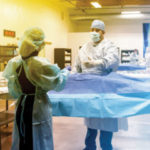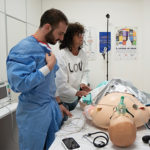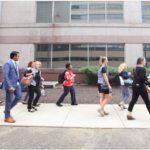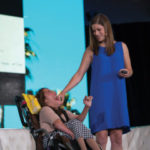Bill Gates is in.
That was the big-name speaker that the American Society for Microbiology (ASM) was courting for its keynoter when we last checked in on the planning process for ASM Microbe 2016. After our previous article went to press, Gates confirmed.
ASM Microbe is something different for ASM, combining two of its previous annual meetings — the ASM General Meeting and the Interscience Conference on Antimicrobial Agents and Chemotherapy (ICAAC) — into one umbrella program.
Nothing epitomizes this brave new world more than Gates. While the Microsoft cofounder and philanthropist has clear topical relevance for the organization’s audience — thanks to the Bill & Melinda Gates Foundation’s work addressing global health challenges — his enormous general-interest profile makes him something of a departure for ASM.
“Typically, [ASM’s] speakers have been primarily from the community, and very prominent scientists — very, very science-focused,” said Kirsten Olean, CMP, CAE, ASM’s director of meetings. “We’re going from [that] place, to Bill Gates, which is really an enormous leap and makes this an even bigger deal than it would be to have Bill Gates for any meeting.”
But while Gates is the big story, by no means is he the only one. Here’s where ASM is on the road to ASM Microbe 2016 — debuting at the Boston Convention and Exhibition Center (BCEC) in June, with a projected 10,000 to 12,000 attendees.
THE GATES EFFECT
While Gates officially confirmed for ASM Microbe in early December, ASM didn’t send out a notification about it until the middle of February, mostly because his appearance created a scheduling challenge — one that Olean thinks ultimately made for a better program. The conference runs from Thursday, June 16, to Monday, June 20, and while ASM’s original plan was for Gates to speak on Saturday evening, he was only available on Thursday.
“When Bill Gates says yes,” Olean said, “you take him on the day that he says he’s going to speak.”
“When Bill Gates says yes,” Olean said, “you take him on the day that he says he’s going to speak.”Thursday was going to be a traditional pre-conference day, with workshops followed by a General Meeting–focused opening session featuring basic-science microbiology lecturers. Olean moved that program from Thursday to Friday; moved the keynote from Saturday evening to Thursday at 5 p.m. and rechristened it the “Opening Keynote Session Featuring Bill Gates”; and left Saturday evening open. The original Thursday speakers all were “very accommodating” about moving to Friday, Olean said, and “there are a lot of things happening on [Saturday] evening on the social front — receptions and things like that. It actually has given us more flexibility to handle some of those things on that night, which has turned out to be a benefit.”
Thursday was going to be a traditional pre-conference day, with workshops followed by a General Meeting–focused opening session featuring basic-science microbiology lecturers. Olean moved that program from Thursday to Friday; moved the keynote from Saturday evening to Thursday at 5 p.m. and rechristened it the “Opening Keynote Session Featuring Bill Gates”; and left Saturday evening open. The original Thursday speakers all were “very accommodating” about moving to Friday, Olean said, and “there are a lot of things happening on [Saturday] evening on the social front — receptions and things like that. It actually has given us more flexibility to handle some of those things on that night, which has turned out to be a benefit.”
Slotting Gates on Thursday also led Olean and her team to rethink how they’d been approaching the entire conference program. While blending the General Meeting’s basic-science community with ICAAC’s more clinical community is a top priority for ASM Microbe, they were looking at this inaugural conference as something of a co-location, with General Meeting content weighted toward the front of the schedule and ICAAC content on the back end. It was assumed that “people would look at the program,” Olean said, “and would choose to come in on whatever day made sense to them relative to the program that was happening.” But as they talked over these scheduling revisions with the chairs of ASM Microbe’s three program committees — representing the General Meeting, ICAAC, and a new Profession of Microbiology track — they realized that might not be the case. Attendees “might have just looked and said, ‘The meeting’s Thursday to Monday, and I’m coming in on Thursday.’”
Gates brought the imbalance of the program into stark relief. Originally, any ICAAC workshops scheduled for Friday carried an additional fee, Olean said, “so if you didn’t want to do that, you really wouldn’t have much programming otherwise for you on Friday if you were an ICAAC person.” With Gates slotted for Thursday, more if not most attendees will arrive in time to see him — meaning there needs to be relevant programming for everyone right from the start of the conference. Olean estimates that her team ended up moving about 25 ICAAC workshops and other sessions to Friday, from Saturday, Sunday, and Monday.
“We were forced to do this,” Olean said, “but it actually turned out to be the right thing for the program in the long run. It actually gets us to a much more integrated meeting, which is our long-term vision for the meeting anyway.”
And they have Bill Gates, who will be interviewed onstage by ABC News Chief Health and Medical Editor Richard Besser about the importance of microbial sciences to the Gates Foundation’s work in areas such as polio eradication and HIV/AIDS prevention. “Our members are focused on a lot of the same things that the Gates Foundation is focused on,” Olean said. “The community of microbial scientists really plays an essential role in the types of things Bill Gates is trying to do with the foundation. That is the message that we’ve also put out to our people: You play an essential role in leading these great challenges that Bill Gates’ foundation is trying to address.”
EARLY INDICATORS
But Gates isn’t even the half of what Olean has been up to since we’d last spoken to her, in November. During our most recent interview in mid-February, after we’d discussed Gates, we moved on to everything else she and her team have gotten done. At the top of the list: posters. The General Meeting and ICAAC each had their own abstract process, and while their program committees had worked together to standardize poster-submission guidelines for ASM Microbe, they had yet to unify their review processes. At first, Olean planned to have them work out a compromise, but eventually she realized “how difficult it was going to be to get us to that point of universal criteria and scoring for abstracts.” Not wanting to “potentially poison the waters for us to get consensus on where we want to go in terms of how we plan the [overall ASM Microbe] program,” Olean said, she decided that for this year, each group would stick with its own review process.
A lot was riding on this. The abstract process opened on Nov. 19 and closed on Jan. 12, and Olean had been looking to the total number of submissions as an advance indicator of conference attendance. In the end, ASM ended up with more than 4,100 submissions — less than the number of posters at the General Meeting and ICAAC combined. Olean is fine with that, for two reasons: First, ASM Microbe is a brand-new conference, so all bets are off. And second, the final ICAAC program was only just held in September, meaning the scientists and researchers in that community had just four months to put together new abstracts — a drastically reduced timeline that likely contributed to fewer submissions for ASM Microbe. “With those two factors,” Olean said, “we were really comfortable with where we ended up — with a very good distribution of basic science versus clinical, and good distribution across our [education] tracks.”
Meanwhile, in the middle of abstract submissions, registration went live — for premium members on Dec. 17, and for everyone on Jan. 7. Like everything else involving ASM Microbe, it meant a lot of startup work. “It wasn’t just, ‘Hey, let’s take last year’s and copy it over!’” Olean said. “We had to really think through the process. We put new things in place in terms of how we register program-committee members and speakers and things like that in order to be better able to track them, and also tried to automate some of those processes a little bit more.”
Fortunately, ASM’s registration company, Experient, is “a great partner,” Olean said, and everything went “very smoothly.” When we talked to Olean a little more than a month after full registration opened, 19 weeks out from ASM Microbe, the numbers were pacing ahead of where they were at a similar point for the 2015 General Meeting and ICAAC 2015 combined. “It’s not exactly apples to apples for us to compare,” Olean said. “But that’s definitely good.”
Also crossed off the to-do list: the big site visit, which ASM made to Boston this past December. During previous visits — in December 2014 and August 2015 — Olean and her team familiarized themselves with their venues, which include the BCEC as well as meeting space at three hotels: the Seaport World Trade Center, the Westin Boston Waterfront, and the Renaissance Boston Waterfront Hotel. They figured out where they were going to put everything, from various education hubs and zones, to signage and human directionals. This past November, Olean had convened a design meeting with Freeman, ASM Microbe’s contractor, at ASM headquarters in Washington, D.C., to discuss how the conference would physically look. Based on that meeting, Freeman created detailed plans for various elements of ASM Microbe.
At the most recent site visit in December — which brought together Olean and her staff, plus partners including Freeman, Experient, and the Greater Boston Convention & Visitors Bureau — Olean had copies of those designs. And she put them to good use. “It was an opportunity for us to literally stand, for example, in one of the [education] track hubs, which is a lounge kind of space, with the sketch and take a look at it and really map it out,” Olean said. “It was taking the designs that we had looked at in draft, and walking the space, and really thinking about how those pieces were really going to work.”
ASM also eyeballed final locations around the BCEC for directionals. They talked to people from the BCEC about Internet, phone, and electrical. They met with catering, audiovisual, and security. And they walked the streets and sidewalks of what they’re calling the conference “campus” — encompassing the BCEC and the three meeting hotels — with an eye on where they’d like to place ASM Microbe flags, banners, and sidewalk clings. “Obviously, the big things are happening at the convention center,” Olean said, “but we also have a lot happening at the other three properties. We want people to feel like they’re still at the meeting, and still at an important part of the meeting, when they leave the BCEC and go to the other properties.”
‘THIS IS NOT THE SAME MEETING’
ASM planned to notify those people whose abstracts were accepted in mid March. Olean anticipated that would lead to a bump in registration, as would Gates’ appearance, which is the focus of various marketing efforts. The submission process for “late-breaker abstracts” opened on Feb. 19 and was slated to close on March 17, with notifications going out in mid April — creating another bump.
It may sound as if things are starting to wind down, but of course they’re not. As of February, one of Olean’s immediate priorities was to work with her program committees on scheduling speakers for ASM Microbe’s new “scientific-track hubs” — located throughout the BCEC, where ASM will offer “informal, short-format programming.” She was also focusing on the Speaker Connection Zone, an area on the show floor where attendees will be able to have follow-up discussions with select speakers who presented earlier in the day. “We’re still working out the formatting of it,” Olean said, “whether it’s an informal standup cocktail round, or at a roundtable with eight or 10 people.”

The Professional Development Zone, also on the show floor, likewise was still coming together, including a career-choice program that will present about a dozen 15-minute talks by a diverse assortment of microbiology professionals. Ditto the Peer-to-Peer Exchange Zone, offering roundtable discussions planned by ASM committees dedicated to women in microbiology, minority affairs, and other areas, with some crowdsourcing. “We’ll be sending out a survey as we get closer to the meeting, to the people who are registered,” Olean said, “saying, ‘What would you love to sit down and talk to your peers about? And oh, by the way, would you be willing to facilitate that?’”
Even as she fine-tunes ASM Microbe 2016, Olean is thinking about 2017. She was planning to bring together ASM Microbe’s Steering Committee — which oversees the three program committees — last month to “look at our path forward,” she said. “How do we want this meeting to look when it’s truly integrated? How do we want it to look in 2017 and beyond? How do we want to plan the program in the future? And backing up from that to say, ‘Okay, how can we start moving toward that in 2017?’”
But back to the present year. There will be a final site visit to Boston, but whereas traditionally that’s happened three to four months out from ASM conferences, for ASM Microbe Olean is aiming for four to six weeks out — when the meeting properties have ASM’s final specifications in hand. “We loved the December site visit,” she said. “I was talking with my assistant director, and I said, ‘What are we going to do with the next site visit? What’s the intent?’ I felt like we’d walked away from December with decisions made…. What we decided was what would be most valuable would be to be able to actually sit down with them once they had everything in hand from us.
“It’s almost like a precursor to the pre-con,” Olean said. “Really, we’ll go through everything in detail, which we’ve actually never done before [at the final site visit]. It’ll be the first time that we’ve done that.”
Olean knows she says that a lot. For her and her team, ASM Microbe has been almost nothing but firsts. That’s partly because it’s a new conference, so there are no preexisting blueprints to work from, but also because Olean is aware of how important it is to make a certain kind of impression. Take the registration space at the BCEC. “It’s incredible,” Olean said. “Freeman’s never designed anything like it before…. We’re inventing from scratch, and it requires a lot more thinking, a lot more back and forth in terms of design.” Was it necessary for everything to be 100-percent original? “It’s just registration, right?” Olean said. “Our General Meeting was [in Boston] two years ago, so a lot of our people have been there fairly recently. I want them to walk in, see what that lobby looks like, and say, ‘Wow, this is not the same meeting.’”
And after this year, Olean and her team will have some blueprints to work from — ones they drew themselves.




